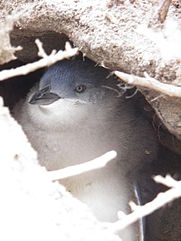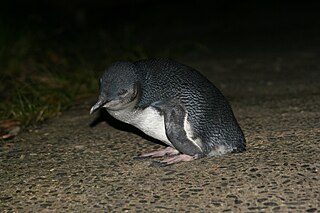
The little penguin is a species of penguin from New Zealand. They are commonly known as fairy penguins, little blue penguins, or blue penguins, owing to their slate-blue plumage and are also known by their Māori name kororā. They are fossorial birds.

The African penguin, also known as Cape penguin or South African penguin, is a species of penguin confined to southern African waters. Like all penguins, it is flightless, with a streamlined body and wings stiffened and flattened into flippers for a marine habitat. Adults weigh an average of 2.2–3.5 kg (4.9–7.7 lb) and are 60–70 cm (24–28 in) tall. The species has distinctive pink patches of skin above the eyes and a black facial mask. The body's upper parts are black and sharply delineated from the white underparts, which are spotted and marked with a black band.
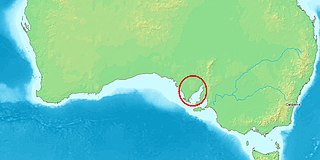
The Spencer Gulf is the westernmost and larger of two large inlets on the southern coast of Australia, in the state of South Australia, facing the Great Australian Bight. It spans from the Cape Catastrophe and Eyre Peninsula in the west to Cape Spencer and Yorke Peninsula in the east.

The macaroni penguin is a species of penguin found from the Subantarctic to the Antarctic Peninsula. One of six species of crested penguin, it is very closely related to the royal penguin, and some authorities consider the two to be a single species. It bears a distinctive yellow crest that resembles a hairdo consisting of macaroni, from which its name is derived. Its face and upperparts are black and sharply delineated from the white underparts. Adults weigh on average 5.5 kg (12 lb) and are 70 cm (28 in) in length. The male and female are similar in appearance; the male is slightly larger and stronger with a relatively larger bill. Like all penguins, it is flightless, with a streamlined body and wings stiffened and flattened into flippers for a marine lifestyle.

The Australasian gannet, also known as the Australian gannet or tākapu, is a large seabird of the booby and gannet family, Sulidae. Adults are mostly white, with black flight feathers at the wingtips and lining the trailing edge of the wing. The central tail feathers are also black. The head is tinged buff-yellow, with a pearly grey bill edged in dark grey or black, and blue-rimmed eyes. Young birds have mottled plumage in their first year, dark above and light below. The head is an intermediate mottled grey, with a dark bill. The birds gradually acquire more white in subsequent seasons until they reach maturity after five years.

Granite Island, also known by the Ramindjeri people as Nulcoowarra, is a small island next to Victor Harbor, South Australia, about 80 km south of South Australia's capital city, Adelaide.

Penguin Island is a 12.5-hectare (31-acre) island off the coast near Perth, approximately 660 metres (722 yd) from Shoalwater. It is home to a colony of 300 little penguins, the largest population of the birds in Western Australia. Since 2007, the island had experienced an 80 percent decline in penguin numbers in 2019 from a peak of 1,600 that year.

Mystery Bay is a small town on the south coast of New South Wales, Australia. Mystery Bay is halfway between Central Tilba and Narooma, two kilometres off the Princes Highway on Mystery Bay Road. At the 2016 census, Mystery Bay had a population of 191. Mystery Bay features a camping area in the Eurobodalla National Park. This park is known for its recreational activities and various species of Bird. Montague Island is close to Mystery Bay and is known for its unusual quantities of Penguin called Eudyptula minor and fur seals. There is also an Infestation of a specific type of House mouse called Mus musculus which has needed eradication because of its damage on the ecosystem.
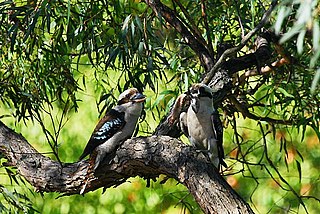
The fauna of the Australian Territory includes representatives from most major Australian animal groups.

The spiny-cheeked honeyeater is the only species in the genus Acanthagenys. It is large for a honeyeater, ranging from 22 to 27 centimeters tall and weighing around 52 grams. The birds are sociable, aggressive, and often observed foraging in large flocks.
The Dion Islands are a group of small islands and rocks lying in the northern part of Marguerite Bay, 11 kilometres (6 nmi) south-west of Cape Alexandra, Adelaide Island, off the west coast of the Antarctic Peninsula. They were discovered by the French Antarctic Expedition, 1908–10, and named by Jean-Baptiste Charcot for the Marquis Jules-Albert de Dion, who donated three motor sledges and whose De Dion-Bouton works produced equipment for the expedition.

Ardley Island is an island 1.9 kilometres (1 nmi) long, lying in Maxwell Bay close off the south-west end of King George Island, in the South Shetland Islands of Antarctica. It was charted as a peninsula in 1935 by Discovery Investigations personnel of the Discovery II and named for Lieutenant R.A.B. Ardley, Royal Naval Reserve, an officer on the ship in 1929–31 and 1931–33. Aerial photography has since shown that the feature is an island with Braillard Point being the headland forming the northeast end of Ardley Island. It has been designated an Antarctic Specially Protected Area because of the importance of its seabird colonies.

The Sir Joseph Banks Group is an archipelago in the Australian state of South Australia located in Spencer Gulf about 20 kilometres (12 mi) off the eastern coast of the Eyre Peninsula. It consists of 21 islands of which eighteen are in the Sir Joseph Banks Group Conservation Park while the surrounding waters are in the Sir Joseph Banks Group Marine Park. It is considered to be an important seabird breeding site.

Middle Island is a small, rocky island lying close to the shore of south-western Victoria, Australia, in Stingray Bay next to the city of Warrnambool. It is a wildlife sanctuary that is home to breeding colonies of Australian little penguins and short-tailed shearwaters. It is closed to general public access because of the low penguin population.
Lipson Cove is a tranquil sandy bay in the Australian state of South Australia on the east coast of Eyre Peninsula overlooking Spencer Gulf. It features in the 2012 book 101 Best Australian Beaches by Andy Short and Brad Farmer.

Louth Island is a 135 ha island located in Louth Bay, Spencer Gulf, South Australia. The island is privately owned, and has previously been used for the grazing of sheep and mining of guano. The island has an old building with sleeping quarters, several beaches, inshore rocky reef and a boat anchorage. It is 17.5 km NNE of Port Lincoln and is easily accessible by boat. The indigenous name for the island is Yorunu.
Rabbit Island is a rarely visited 32 hectares island located in Louth Bay, Spencer Gulf, South Australia. It also bears the historic French name of Ile Raynal. Unlike the larger, privately owned Louth Island which sits 3 kilometres to the north-west, Rabbit Island is public land and part of the Lincoln National Park. A diversity of native flora and fauna species have been recorded on the island.

The Australian little penguin, also called the fairy penguin, little blue penguin, or blue penguin, is a species of penguin from Australia and the Otago region of New Zealand. The species was described as Spheniscusnovaehollandiae in 1826. It was later reclassified as Eudyptulaminornovaehollandiae, a subspecies of the little penguin. After a 2016 study, Eudyptula novaehollandiae was again recognised as a distinct species.

The Summerland Peninsula is located at the western end of Phillip Island in Victoria, Australia. The peninsula lies within the Gippsland Plain Bioregion and is a site of high conservation significance.
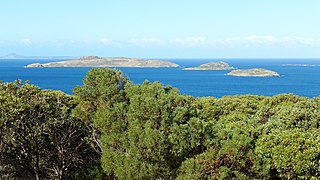
Cull Island, also known as Culls Island and Gull Island, is an island off the south coast of Western Australia in the Recherche Archipelago. It is located about 6.5 kilometres (4 mi) southeast of Esperance and occupies an area of 68 hectares.



